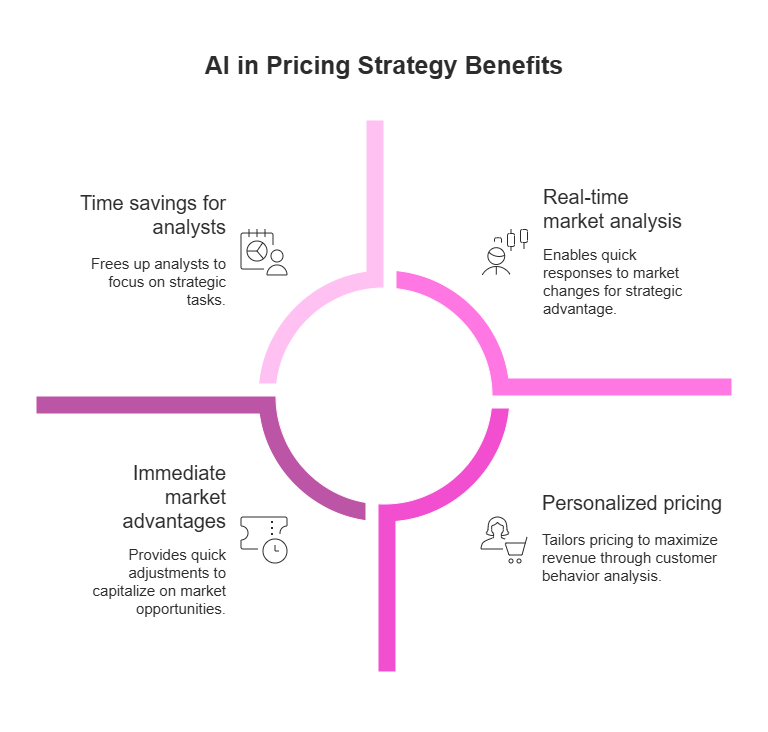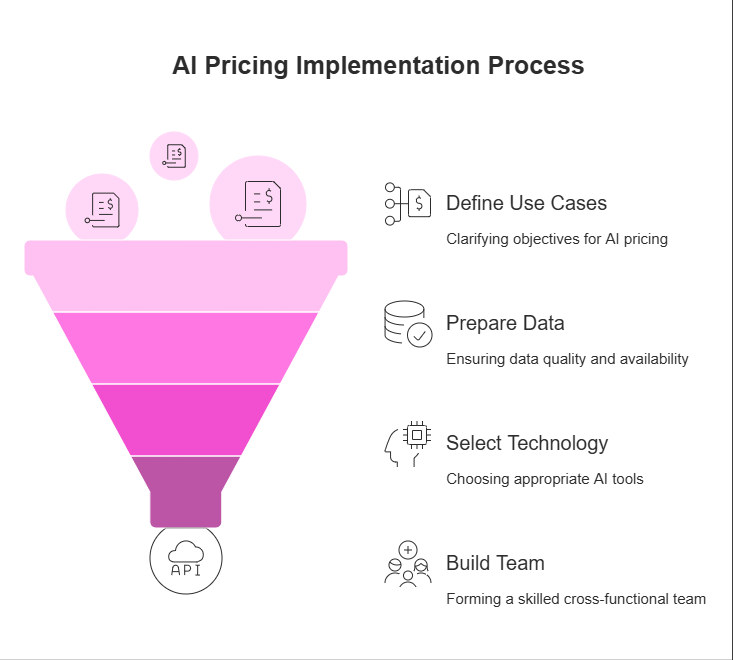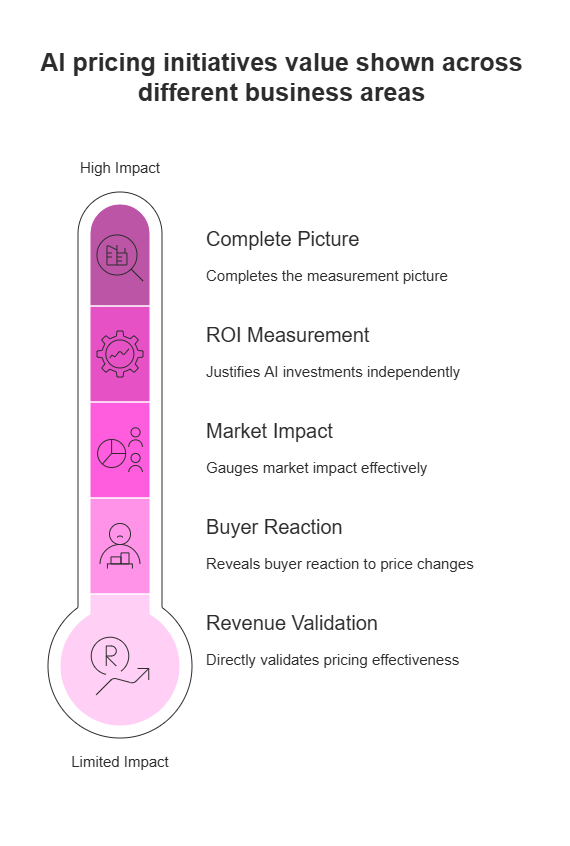AI pricing agents have transformed how businesses approach market analysis and pricing strategies. This article explores the shift from static spreadsheets to dynamic, data-driven systems that respond to market conditions in real-time. Companies implementing these tools see revenue increases up to 30% while saving countless hours previously spent on manual adjustments.
Throughout this guide, you’ll discover practical insights about AI pricing technology and its applications across different industries. From retail to travel, manufacturing to subscription services, these tools offer competitive advantages for organizations of all sizes. We’ve included real case studies showing measurable results from businesses that successfully deployed AI pricing strategies.
Here’s what you’ll learn:
- How AI pricing differs from traditional methods and why it matters
- Core benefits including revenue growth, operational efficiency, and competitive intelligence
- Technical aspects of market data analysis for pricing decisions
- Industry-specific applications with real-world examples
- Step-by-step implementation guidance for your business
- Ways to overcome common challenges like data quality and privacy concerns
- Emerging trends that will shape pricing technology through 2027
- Essential KPIs to measure success and justify investments
- Proven case studies demonstrating ROI across various sectors
- Strategic next steps to begin your AI pricing journey
Whether you’re new to AI pricing or looking to enhance existing strategies, this guide provides actionable insights to improve your market positioning and boost profitability.
Understanding AI Agents for Product Pricing and Market Analysis
AI agents actually represent sophisticated digital systems that sort of continuously monitor market conditions. These tools differ greatly from legacy pricing methods. Those relied on spreadsheets, manual updates, and rigid rules. In a way, traditional pricing tools operated on historical data snapshots, often becoming outdated almost immediately after implementation.
The shift from static to dynamic pricing models basically marks a significant change in retail strategy. Early systems, you know, followed predetermined rules with limited adaptability. Modern AI solutions, however, learn from patterns across vast datasets. This transition essentially allows businesses to respond instantly to competitor moves, demand fluctuations, and inventory changes.
Several core components, in fact, power these intelligent systems. Machine learning algorithms form the analytical engine that processes multiple data streams. Data ingestion workflows continuously collect information from competitor websites, market trends, and customer behavior. Decision engines then translate these insights into actionable rate recommendations.
Many businesses hesitate to adopt AI pricing due to perceived complexity. Fortunately, platforms like AI agent builders now offer no-code solutions that slash development time by half. These platforms enable marketing teams to create sophisticated models without extensive programming knowledge.
Small retailers can actually compete with larger competitors through these accessible tools. Dynamic pricing models adjust to market conditions in real-time, unlike traditional pricing tools that remain static. This democratization of technology means businesses of all sizes can leverage advanced analytical capabilities for better market positioning.
Benefits of Implementing AI Agents for Pricing Optimization
AI-powered pricing strategies actually boost revenue by up to 30% in the first year. This impressive growth happens because AI can run thousands of pricing experiments at once. Human analysts might miss these optimal price points that AI easily discovers.
Operational efficiency offers another compelling advantage for pricing teams. Studies show that 90% of business users report significant time savings when using AI tools. These savings translate into a 25% productivity boost in most cases. Pricing analysts now focus on strategy instead of spending hours adjusting spreadsheets.
Competitive intelligence capabilities provide perhaps the most strategic value in today’s market. AI agents continuously monitor:
- Competitor price movements across product lines
- Market demand fluctuations by region
- Supply chain disruptions affecting pricing
- Consumer willingness-to-pay metrics
This responsiveness lets businesses adjust prices in minutes, not days. In a way, this creates immediate market advantages.
Personalized pricing represents the final frontier for revenue optimization. AI analyzes customer behavior to identify price sensitivity by segment. This approach creates a win-win scenario that’s extremely valuable. Customers receive fair pricing while businesses maximize both conversion rates and profit margins.

How AI Agents Analyze Market Data for Pricing Decisions
Sophisticated data analysis capabilities actually transform raw information into actionable pricing insights. In a way, these systems process market data through multiple analytical lenses, creating a comprehensive view of pricing opportunities.
Market monitoring forms the backbone of effective pricing strategies. Web scraping tools, continuously extract pricing information from competitor websites and distribution channels.
Price elasticity modeling is extremely valuable for businesses today. AI systems calculate how demand fluctuates when prices change across different product categories. These models consider several factors, such as:
- Historical sales data correlated with previous price points
- Seasonal variations that obviously affect willingness to pay
- Product relationships that might be complementary or substitutes
- Regional indicators that, at the end of the day, influence purchasing power
Customer segmentation adds another dimension to pricing intelligence. AI agents for marketers analyze purchasing patterns to create personalized offers, which lift conversion rates by 15%.
Trend detection capabilities, in some respects, complete the analytical toolkit. Systems aggregate data from social media and search trends to identify emerging patterns. This forward-looking analysis helps businesses anticipate market shifts rather than just react to them.
Industry Specific Applications of AI Pricing Agents
In a way, different sectors adapt AI pricing technology to address unique challenges in their business environments. These specialized applications show how versatile pricing algorithms have become across various industries.
In retail, major e-commerce platforms adjust prices every 15 minutes during peak shopping periods. They respond to inventory levels, competitor moves, and browsing patterns. AI sales agents enhance this approach by embedding pricing recommendations into sales workflows, which boosts lead conversion rates by 35% when offering tailored pricing options.
Yield management algorithms transform travel and hospitality businesses in ways that would be nearly impossible to execute manually.
Complex product configurations really challenge manufacturing pricing models. Value-based models drive subscription services to analyze usage patterns and perceived value.
Implementing AI Agents for Your Pricing Strategy
AI pricing implementation works best with careful planning, instead of rushing deployment. Companies taking time to build solid foundations achieve better results and avoid costly mistakes.
Start by examining your current pricing infrastructure. Look at existing systems and identify opportunities. Then, define your AI pricing use cases clearly. You might focus on competitive positioning, dynamic pricing, or customer-specific offers.
Data preparation is, in a way, the most critical phase. Consider these essential steps:
- Identify required data sources (competitor prices, sales history, inventory)
- Set up automated collection for real-time information
- Create cleaning protocols for missing values
- Develop unified storage with security measures
- Implement validation to ensure data quality
Technology selection really depends on your needs. Cloud solutions offer scalability for most organizations. Specialized AI pricing platforms work well for teams without extensive data science resources.
People ultimately determine success in this process. Form a cross-functional team with pricing analysts and IT specialists. Develop team training programs that build technical skills and trust in AI recommendations.

Overcoming Challenges in AI Driven Pricing
AI pricing systems offer remarkable benefits, yet they actually come with several challenges that need careful handling. Addressing these hurdles proactively helps prevent costly mistakes and, in a way, builds stronger trust among stakeholders.
Data quality, of course, remains a primary concern for most organizations. AI pricing algorithms require high quality datasets to deliver reliable results. Many companies, however, struggle with fragmented or outdated pricing information. Establishing rigorous data governance protocols helps minimize this risk. Implementing automated validation checks and regular quality audits can significantly improve outcomes.
The “black box” nature of complex algorithms creates another significant hurdle for pricing teams. When staff can’t explain why a system recommended certain price points, both internal adoption and customer confidence suffer.
Privacy concerns demand serious attention in today’s regulatory environment. Customer data fuels personalized pricing strategies. Regulations like GDPR and CCPA, meanwhile, impose strict requirements on data usage.
Smart organizations typically establish several safeguards to address these concerns. These include:
- Clear data minimization principles
- Strong encryption for sensitive pricing information
- Comprehensive audit trails for all decisions
- Regular privacy impact assessments
- Customer-facing transparency about data usage
Compliance requirements vary significantly by industry and region, too. Financial services face strict oversight on pricing practices. Retail businesses must navigate different consumer protection laws. Developing cross-functional compliance teams helps organizations maintain pricing agility.
Human oversight remains essential despite advanced automation capabilities. Successful implementations maintain what we call a “human in the loop” approach for critical decisions.
This approach allows AI to generate recommendations while trained professionals review decisions. This is particularly important for high-value transactions or sensitive customer segments.
Balancing technological capabilities with ethical considerations ultimately creates more sustainable AI pricing systems. Organizations that address these challenges proactively will likely achieve better long-term results than those focused solely on automation.
Future Trends in AI Pricing and Market Analysis
AI pricing technology continues to evolve at a rapid pace. Several key innovations will reshape market analysis approaches by 2027, creating new opportunities for businesses.
Prescriptive intelligence, rather than just predictive analysis, will drive the next wave of pricing tools. While current systems tell us what might happen, next-generation solutions will sort of automatically suggest specific actions to maximize profits. As a matter of fact, this shift allows pricing teams to focus more on implementing growth strategies instead of just interpreting complex data sets.
Behind the scenes, too, integration capabilities are changing dramatically. You know how today’s AI tools often work separately from other systems? Well, future platforms will pretty much connect seamlessly with existing ERP and CRM infrastructure. This kind of unified ecosystem essentially incorporates real-time inventory, production costs, and customer data into pricing decisions.
Autonomous pricing represents another exciting frontier. According to AI agents market trends, this sector will grow approximately 35% annually through 2027. In fact, nearly 60% of executives plan to implement these technologies for pricing functions.
Cross-channel optimization strategies are likewise evolving rapidly. Next-generation AI will, in some respects, coordinate pricing across physical stores, e-commerce platforms, and direct sales channels. This approach basically ensures consistency while adapting to unique channel dynamics.
Companies that embrace these technologies gain sustainable advantages. By viewing AI as a strategic partner and maintaining human oversight for important decisions, we can create pricing ecosystems that thrive in increasingly complex markets.
Measuring Success with KPIs for AI Driven Pricing
AI pricing initiatives need a clear measurement framework to show their value. Smart businesses track KPIs across different areas to see what works. Without these metrics, teams often struggle to justify their tech investments.
Revenue metrics provide direct validation of pricing effectiveness. We typically look at gross margin percentage, average order value, and customer revenue before and after implementation. In a way, these numbers tell the real story.
Customer response metrics reveal how buyers react to price changes:
- Price elasticity by product category and segment
- Cart abandonment rates versus historical data
- Conversion changes after price adjustments
- Customer lifetime value over time
- Purchase frequency across price points
Competitive positioning KPIs, help gauge market impact pretty well. Many teams set up automated price monitoring across products. This approach tracks both how often and how much competitor prices change in the market.
Operational efficiency gains often justify AI investments on their own. AI agent pricing models influence ROI measurement in different ways. Usage-based approaches reduce budget variability by 15%. Meanwhile, outcome-based models link costs directly to results, which improves accountability.
Process improvement metrics complete the measurement picture.

Real World Case Studies of AI Pricing Success
Theory only takes us so far. Real-world results actually validate the transformative potential of AI pricing strategies. These case studies showcase how different businesses achieve measurable success through intelligent pricing.
A national retail chain faced intense competitive pressure. They implemented AI-driven pricing across 5,000 high-volume SKUs. Their previous approach, in a way, relied on manual checks and gut feelings. After deploying AI that monitored competitor pricing hourly, they achieved a remarkable 20% net margin uplift within 90 days.
E-commerce businesses have seen similar wins. One specialty online store struggled with static pricing that ignored customer segments. AI agents for marketers enabled them to create dynamic offers based on behavior patterns. This approach, sort of like a digital sales assistant, boosted conversion rates by 18% through personalized pricing.
Subscription businesses, too, benefit from AI pricing strategies.
Conclusion and Strategic Next Steps
AI pricing agents transform business operations in significant ways. Actually, these systems reshape pricing strategies while giving companies new market analysis capabilities. Organizations using this technology can respond to market shifts more effectively and, in a way, boost revenue performance.
Your AI pricing roadmap should basically follow these steps:
- Assessment: Check current processes and data availability
- Use case definition: Find specific challenges with measurable impact
- Data preparation: Ensure clean data for training
- Technology selection: Pick solutions matching your needs
- Implementation: Deploy gradually with feedback loops
- Measurement: Track KPIs to verify business impact
Early pilot metrics really matter for success. You might want to monitor revenue lift, margin improvements, and competitive win rates. Collecting both numbers and team feedback helps build confidence throughout your organization.
Starting with targeted pilot projects can help manage AI costs and reduce implementation risk by nearly 40%. This approach provides valuable learning opportunities too.
The future, of course, belongs to companies embracing AI-powered pricing intelligence. Those moving decisively now will gain advantages that competitors can’t easily match. So start your journey with a focused pilot, measure results carefully, and scale what works. The path to pricing excellence awaits—take that first strategic step today!



